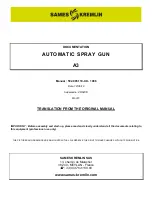
HOW DOES YOUR SPRAY GUN SHAPE UP?
No matter how experienced the sprayer, merely
triggering and moving a gun in space will not
reveal any of the performance characteristics vital
to a top quality finish. A simple brief static spray
pattern test will immediately highlight any
potential problems before the gun is used on the
painstakingly prepared workpiece or vehicle.
Follow the procedure explained below and
compare the pattern to our examples. If your
result resembles the examples then look at the
corrective measures before you apply paint to the
workpiece.
(1) Ensure that you have the correct Air Cap, Fluid
Tip and Needle set-up on the gun to match the
material being applied.
(2) Tape a piece of brown paper (approx. ½ metre /
20” square) onto the spray booth wall at shoulder
height.
(3) Having set the gun at the recommended inlet or
atomising air pressure, hold it at he correct target
distance and spray at the paper without moving the
gun.
Normal Pattern – Ready
to Spray
Intermittent Spray Fan or
Fluttering
Good balance and uniformity
?
Symmetrical pattern shape
?
Good working height and
width
?
Uniform distribution of
material (Verify by
horizontal spray-out)
?
Air in the fluid passageways
?
Insufficient paint in the cup
?
Fluid tip loose
?
Fluid needle packing or packing
screw loose
?
Cup vent hole clogged
Banana Pattern
Heavy Top or Bottom
Pattern
?
Air cap horn hole dirty or
damaged
?
Test spray pattern, rotate
180
o
and test again to
isolate horn hole cause
location
?
Clean air cap thoroughly
?
Replace air cap if necessary
?
Fluid tip or cap dirty or
damaged
?
Test spray pattern, rotate 180
o
and test again to isolate cause.
?
Clean both items thoroughly
?
Replace Fluid tip or Air cap if
necessary
Single Split Pattern
Centre Heavy Ellipse
?
Too much air for fluid
quantity used
?
Reduce air pressure at
regulator
?
Increase fluid flow by
changing fluid tip size
opening needle control
knob
?
Bad air or paint setting
?
Viscosity too high – thin with
solvent
?
Fluid flow too high – reduce
?
Air pressure too low – increase
Double Split Pattern
Ball End Heavy Pattern
?
Too much air for fluid
quantity used
?
Reduce air pressure at
regulator
?
Increase fluid flow by
changing fluid tip size or
opening needle control
knob
?
Too much fluid flow
?
Change fluid tip for smaller size
?
Reduce flow using fluid needle
control
?
Reduce fan size using fan
control
STATIC PATTERN TEST
Having examined the vertical spray pattern for uniformity of shape and size, now turn the air cap through 90
o
and static spray
a horizontal pattern making sure you trigger for long enough to load the shape with material. Then watch to see the formation
of the run-outs of material across the full width of the spray pattern.
This will highlight how well the material is distributed throughout the spray pattern. If the run-out is more obvious at the
centre or at the ends then this indicates a problem.
TYPICAL GOOD PATTERN RUN-OUT
TYPICAL BAD PATTERN RUN-OUT



























